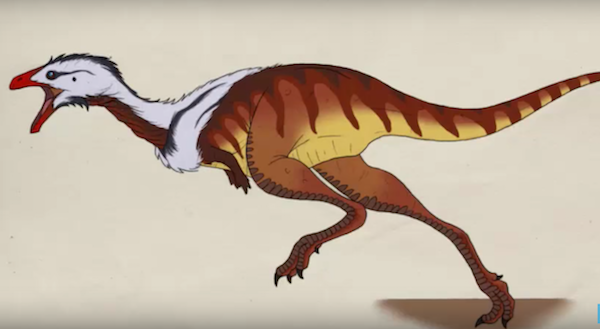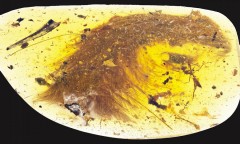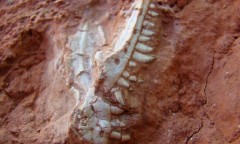By Vishal Goel, | December 25, 2016

The dinosaur species Limusauras lost teeth after maturing into adulthood. (YouTube)
Scientists in China have discovered a dinosaur species called the Limusaurus which developed sharp teeth for eating meat after birth but lost them after reaching adulthood, thereafter becoming vegetarian.
This trait was found particularly among the Limusaurus species, small dinosaurs that scampered across north-western China 160 million years ago. It has not been seen in any other dinosaur or other prehistoric creature.
Like Us on Facebook
Scientists said that the fossils of nineteen of the dinosaur species, ranging in age from under a year to ten years, showed that juveniles had small and sharp teeth, but adults developed a toothless beak. According to scientists, this is one of the discoveries in which fossils of a dinosaur species ranging from babies to adults have revealed anatomical changes that unfold as an animal matures. Such tooth loss is called ontogenetic edentulism. Some animals alive today have it including the egg-laying Australian mammal, the platypus.
The adult Limusaurus were found with stones called gastroliths that some plant-eating dinosaurs used to swallow to grind up plant material in their stomachs. The tooth loss and gastroliths indicate that Limusaurus underwent a dramatic change in diet from birth to adulthood, starting life perhaps eating insects and small vertebrates and later turning to plants.
Physical Structure of Limusauras
The dinosaur species were lightly built and two-legged with short arms, and long, slender legs. They may have had feathers covering at least part of their body. The largest ones were just under two metres long. This cluster of dinosaurs, found in the Xinjiang province, apparently died after getting trapped in mud pits.
"It probably looked something like an emu with a long tail," said Joey Stiegler, a paleontologist at George Washington University and one of the researchers behind the study published in the journal Current Biology.
Limusaurus is a member of the theropod dinosaur group from which birds evolved.
James Clark, a paleontologist at George Washington University, said the findings suggest that the species might have gone through a similar development. James further added that the discovery throws light on the complexity in growth and development than was previously suspected.
Birds, which first appeared about 150 million years ago, evolved from small feathered dinosaurs. The earliest ones had teeth, but over tens of millions of years, many evolved toothless beaks like birds today. The last birds with teeth died with the dinosaurs, about 66 million years ago.
-
Use of Coronavirus Pandemic Drones Raises Privacy Concerns: Drones Spread Fear, Local Officials Say

-
Coronavirus Hampers The Delivery Of Lockheed Martin F-35 Stealth Fighters For 2020

-
Instagram Speeds Up Plans to Add Account Memorialization Feature Due to COVID-19 Deaths

-
NASA: Perseverance Plans to Bring 'Mars Rock' to Earth in 2031

-
600 Dead And 3,000 In The Hospital as Iranians Believed Drinking High-Concentrations of Alcohol Can Cure The Coronavirus

-
600 Dead And 3,000 In The Hospital as Iranians Believed Drinking High-Concentrations of Alcohol Can Cure The Coronavirus

-
COVID-19: Doctors, Nurses Use Virtual Reality to Learn New Skills in Treating Coronavirus Patients











